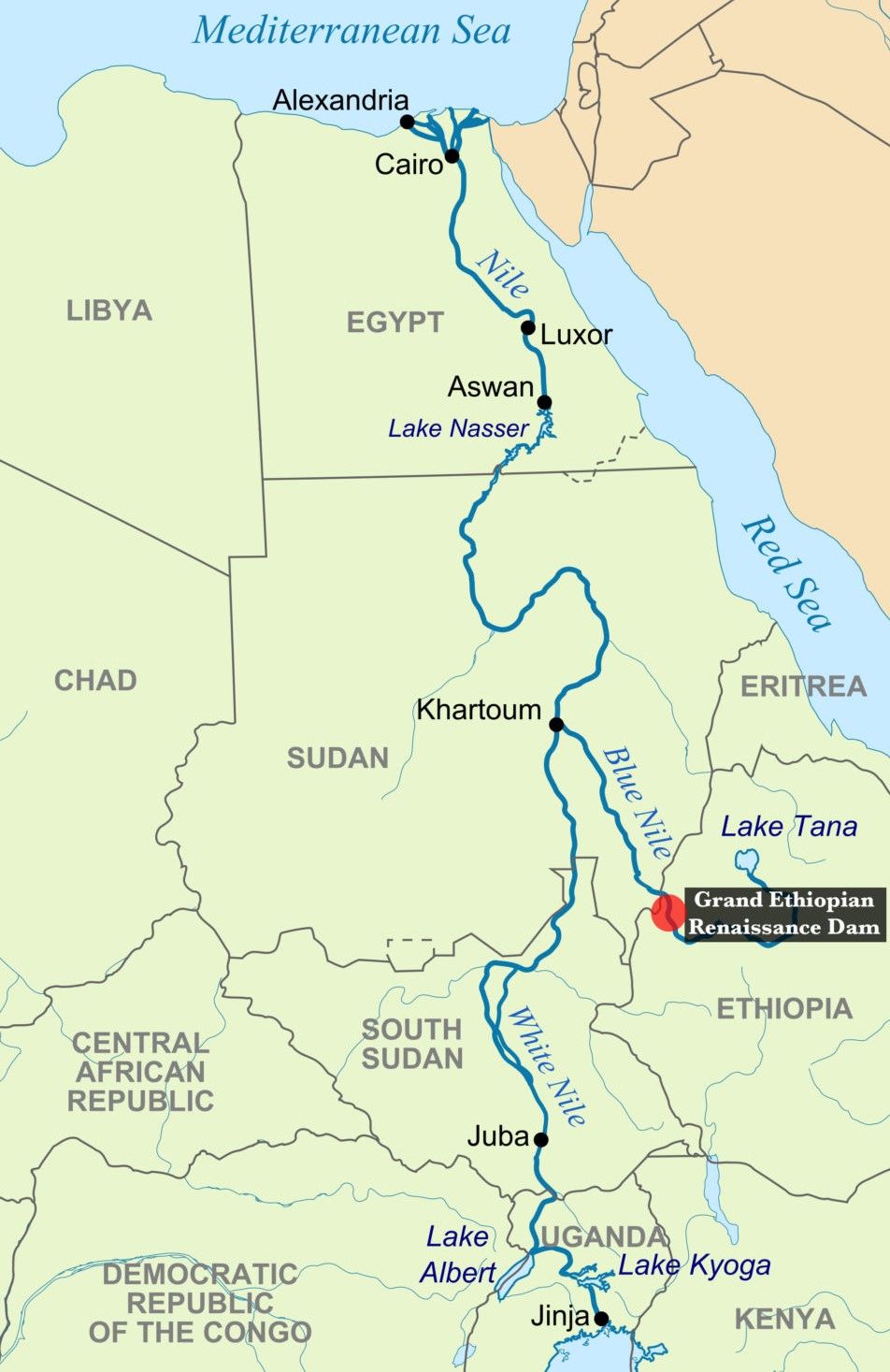Africa is the only continent on the globe with a predominantly youthful population. Despite being plagued with tyrannical rulers, the governments of some its countries have sought to address the needs of its citizens, particularly for water and electric power, without which further economic development founders. This is the case with the monumental engineering project of the Great Rift in east Africa: Tālāqu ye-Ītyōppyā Hidāsē Gidib (in Amheric), better known as the Grand Ethiopian Renaissance Dam (GERD).
Between 1956 and 1964, American engineers had surveyed the Abyssinian Massif region as a promising source of hydroelectric power. Unfortunately, civil wars, political instability and intermittent military incursions delayed construction until 2011. In the wake of gradual reforms, three prime ministers: Meles Zenawi, Hallemariam Desalegn and Abiy Ahmed have successively overseen the dam’s development since that time.
This year, the dam is about ninety percent complete and after three years of filling the Millennium reservoir aided by heavy rains, GERD is configured to produce more than five gigawatts of hydroelectric power to its grid. For comparison, the Hoover Dam and the Aswan High Dam can each supply two gigawatts. (One kilowatt constitutes a thousand joules of energy per second, or 1.36 horsepower.)

After suffering from rolling blackouts for decades, such grid capabilities will not only provide the Ethiopian people with reliable electricity and enable industrialization, but the excess power can be exported to neighboring countries. For although the potential benefits extend regionally, GERD has been funded internally through bonds and private investments, and energy export sales will provided needed revenue.
Current and Future Regional Tensions
However, not everyone has welcomed this mammoth project. GERD has raised objections from two nations downstream of Ethiopia’s new dam, namely Sudan and Egypt. Complaints from the latter especially have complicated international financing.
As has been the case for the past five thousand years, the Nile supplies Egypt and its people with virtually all of its water supply and brings life to the strip of fertile soil along its banks and the Delta that empties into the Mediterranean. Beyond that lies the vast and inhospitable Sahara Desert. Since construction of the Aswan High Dam in 1970, the Nile also provides hydroelectric power to that nation.
The Nile’s sources originate further south, primarily from the White Nile that meanders from Uganda through South Sudan, and the Blue Nile that originates at Lake Tana in the Ethiopian highlands. The latter provides three-fifths of the year-round water for the Nile, and over four-fifths during the summer. The Blue and White tributaries join at Khartoum, the capital of Sudan.
In 1929, The United Kingdom granted Egypt and Sudan exclusive control over the Nile waters, and thirty years later the latter two negotiated a bilateral agreement further reinforcing that claim. Ethiopia doesn’t acknowledge that arrangement, and exploited Egyptian political turmoil during the Arab Spring (2011-12). With the anticipation of electric power from GERD, Sudan’s concerns have partially ameliorated. The reduction of sediment through GERD is also expected to improve the longevity of the Sennar and Roseires dams downstream in Sudan.
Egypt however, remains implacable about GERD’s existence and has demanded international agreement before granting permission to Ethiopia. Due to Ethiopia’s control of the Blue Nile’s water release, Egypt has labeled GERD an existential threat and implies its military capability to attack and disable the structure. In response, Ethiopia has purchased aerial defense systems from Russia and Israel to counter possible air-strikes.
Meantime, Ethiopia has invested heavily in public infrastructure, including GERD, to reduce poverty and improve living standards for its population of 124 million people. Its government has sought economic growth despite horrific conflict in the Tigray region. These battles raged for two years from November 2020 to November 2022, causing estimated fatalities (both civilian and military) of a half-million or more. (By contrast, Russian invasion of Ukraine yields fatal casualties of about one-fifth as many.)
Speculation abounds as to whether Egypt would attempt aerial bombardment to wreck GERD. Such an unprovoked attack could prompt a regional war. Egypt and Sudan have respective populations of 108 million and 47 million. Consequently, Ethiopia would face a formidable combined adversary in an armed retaliation. Nonetheless, possible imposition of economic sanctions could devastate Egypt’s economy. Moreover, injury to such an expensive investment might incentivize alliances between Ethiopia, Djibouti, Kenya and other neighbors over the power loss. Time will tell.
Hydropower and Its Future in Africa
Dams constitute an engineering marvel, holding back water in an artificial lake and controlling its effluence for various intended purposes. The oldest operational such construction was built in the Late Bronze Age (fourteenth century BC) along the Orontes in Syria for irrigation. The Middle Bronze Age irrigation dam at Mā’rib in Yemen (subsequently expanded in Iron Age II) facilitated the great wealth of the Sabaean kingdom, as attributed to its queen (1 Kings10:1-2; 2 Chronicles 9:1) by the royal court at Jerusalem.
Today, dams constitute an important source of electrical power. Nuclear fission reactors preferably operate at a base load near peak capacity, but hydroelectric dams have more flexibility in adjusting power output, depending on reservoir level and downstream flood concerns. Contemporary lobbying focuses on replacing coal, oil and natural gas with “renewable” sources, i.e., those not accumulated within the earth’s crust. However, such advocates devote an inordiante amount of attention to boutique fetishes of photovoltaic conversion and wind-driven vane spinning, neither of which can be expanded at scale and require enormous mineral extraction. By contrast, hydro and nuclear power generation provide regular and reliable electrical delivery, and impose far less demanding encumbrances on land than their proposed “green” alternatives.
The infeasibility of any random location imposes practical limitations. Dams require water flow to operate. Hydroelectric dams operate in principle via kinetic energy from falling water that turns magnetic rotors (via turbines) surrounded by stationary magnets. The fluctuating magnetic field induces an oscillating electric current to tap into a power grid. Of these, hydroelectric dams provide the bulk of this energy by controlling the gravitational descent of water along rivers. In America, hydroelectric adaptation of underutilized dams could gain over a hundred gigawatts of additional power.
With the exploitation of electric generation in Ethiopia and perhaps the proposed Grand Inga Dam in Congo, central African nations will vastly improve their ability to provide their growing populations with sufficient water, nourishment and industry. These endeavors offer encouragement that humanity can avoid future dystopias of famine and pestilence. The emergence into the modern world of this populous region – one of the few where birth rates are above replacement – holds promise for our global future. The final scene in “The Hunt for Red October” aboard the commandeered Typhoon-class submarine showed Jack Ryan softly announcing to Marko Ramius “welcome to the new world, sir.”
So it can be for Ethiopia.
Photo Credit-

